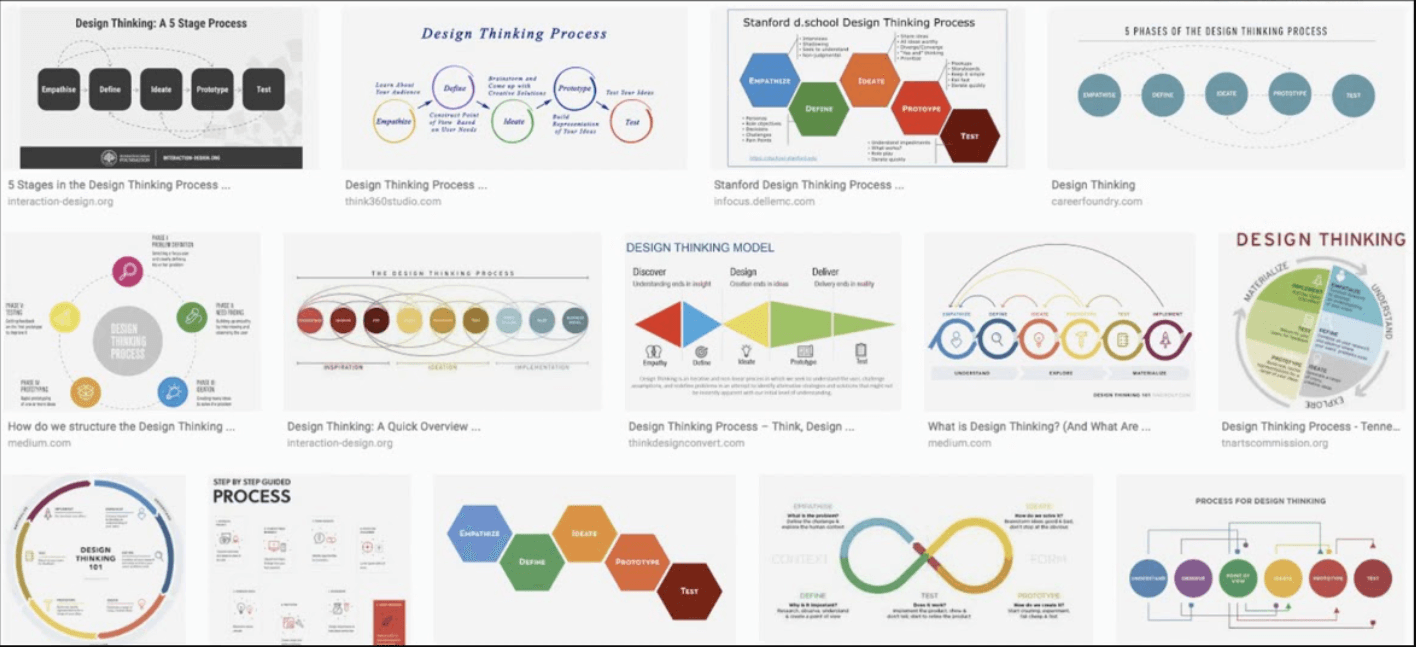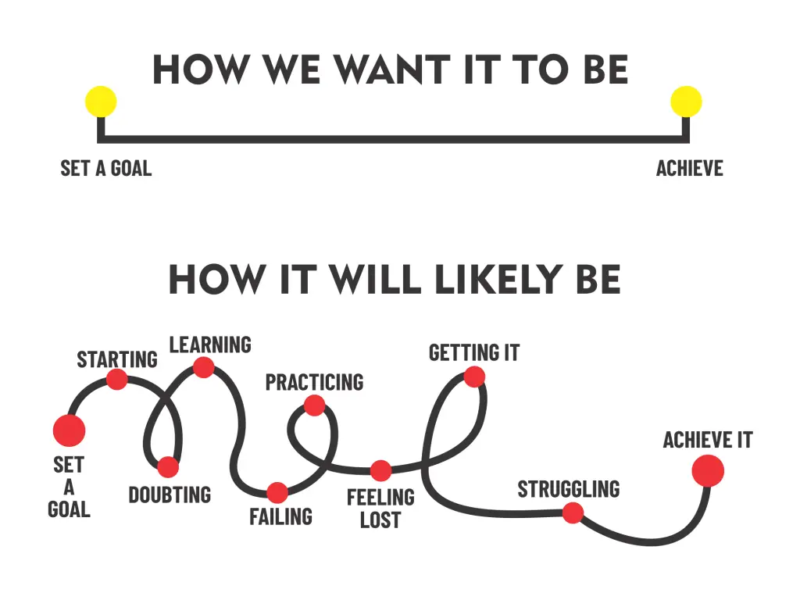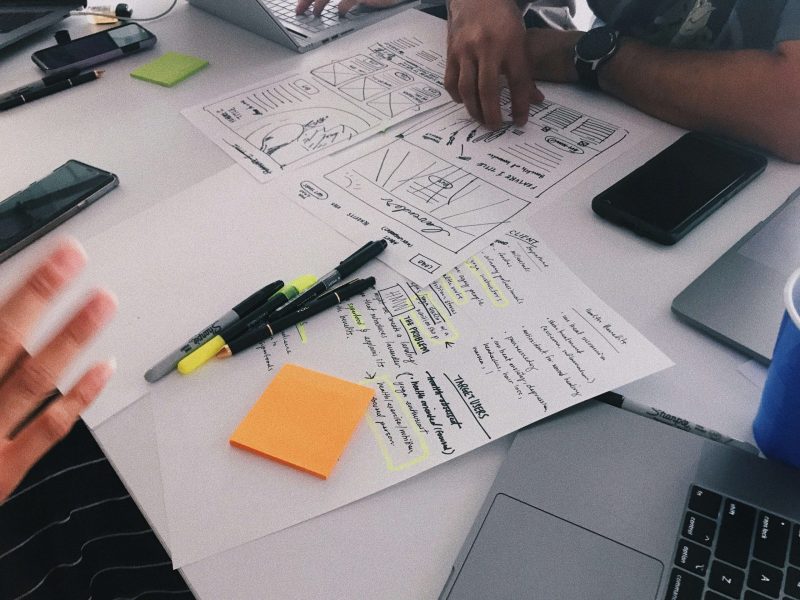Design Thinking frameworks and methodologies serve as essential guides to navigate through complex problems and create user-centric solutions.
Among the most commonly used frameworks in the industry are the Double Diamond model, the User-Centered Design (UCD) process, and the Lean UX process.
Each framework has its unique strengths, making it suitable for different contexts and project needs.
The Double Diamond Model
The Double Diamond model, developed by the Design Council UK in 2005, emerged from an extensive study of design processes across various industries. This four-phase design process framework is widely adopted in the UX industry, offering a structured approach to tackling complex challenges. Its structured approach helps teams solve complex problems by focusing on exploration, definition, development, and delivery.
1. Discover Phase:
This phase emphasizes understanding the problem space through extensive research.
- Inputs: Design briefs, project goals, and research questions.
- Activities: User interviews, surveys, ethnography, and usability testing.
- Outputs: Research findings, insights, and a clear problem statement (e.g., “Users find it difficult to complete the sign-up process due to unclear instructions and excessive form fields”).
- Best Practices: Employ diverse research methods to build a robust understanding of user needs and business goals.
2. Define Phase:
This stage narrows the focus to a specific problem based on insights from the discovery phase.
- Inputs: Research findings and problem statements.
- Activities: Creating empathy maps, personas, and user journeys.
- Outputs: Design briefs, concepts, and directions.
- Key Principle: Achieve clarity in problem definition to drive meaningful solutions.
3. Develop Phase:
Designers and developers work together to create and test prototypes.
- Inputs: Design briefs and concepts.
- Activities: Rapid prototyping and usability testing.
- Outputs: High-fidelity prototypes and user feedback.
- Best Practices: Iterate based on feedback to refine solutions.
4. Deliver Phase:
The final phase focuses on implementing the validated solution.
- Inputs: High-fidelity prototypes and user feedback.
- Activities: Development, deployment, and post-launch analysis.
- Outputs: A market-ready product and continuous improvements based on user feedback.
- Key Principle: Deliver a product that balances user needs and business objectives.
Why Use the Double Diamond Model?
This framework’s systematic approach ensures a thorough exploration of the problem space and iterative refinement of solutions. It’s especially effective for projects requiring deep research and structured delivery.
The User-Centered Design (UCD) Process
The User-Centered Design (UCD) process places the user at the core of the design journey. It’s an iterative methodology aimed at addressing the needs, wants, and limitations of end users.
1. Discovery and Research:
This phase focuses on gathering insights about users and their needs.
- Inputs: Project goals, design briefs, and research questions.
- Activities: Interviews, surveys, usability testing, and ethnographic studies.
- Outputs: User personas, journey maps, and insights.
- Best Practices: Involve users actively and leverage multiple research methods.
2. Design Phase:
Leveraging research findings, teams ideate and prototype potential solutions.
- Inputs: Personas, insights, and user journeys.
- Activities: Creating wireframes, empathy maps, and low-fidelity prototypes.
- Outputs: Design concepts and prototypes.
- Best Practices: Collaborate with users during ideation and iteration.
3. Evaluation Phase:
The focus here is on testing the designs to gather actionable feedback.
- Inputs: Prototypes and design concepts.
- Activities: Usability tests, A/B testing, and heuristic evaluations.
- Outputs: Refined designs and validated solutions.
- Key Principle: Use user feedback to iteratively improve the product.
4. Implementation and Deployment:
The final phase involves building and launching the product.
- Inputs: Refined prototypes and design revisions.
- Activities: Agile development, integration, and deployment.
- Outputs: Final product and ongoing user feedback.
- Best Practices: Continuously measure user satisfaction to inform future updates.
Why Use UCD?
UCD’s iterative nature ensures that the final product aligns closely with user expectations. It’s ideal for projects where user needs and behaviors are highly dynamic.
The Lean UX Process
The Lean UX process is a highly iterative methodology inspired by Lean Startup principles. It prioritizes speed and adaptability, enabling teams to focus on delivering a Minimum Viable Product (MVP) quickly.
1. Problem and Solution Hypotheses:
The process begins with defining the problem and hypothesizing solutions.
- Inputs: Design briefs, goals, and assumptions.
- Activities: Creating problem statements and formulating hypotheses.
- Outputs: Hypotheses and prioritized assumptions.
- Key Principle: Focus on the core problem to maximize impact.
2. Design and Build Phase:
Rapid prototyping takes center stage.
- Inputs: Hypotheses and assumptions.
- Activities: Developing low-fidelity prototypes.
- Outputs: Testable prototypes and early feedback.
- Best Practices: Use simple, quick prototypes to validate ideas.
3. Validation Phase:
Testing with users validates or refutes the hypotheses.
- Inputs: Prototypes and initial feedback.
- Activities: User testing and data analysis.
- Outputs: Design revisions and actionable insights.
- Key Principle: Prioritize learning over perfection.
4. Learn and Iterate:
Feedback informs further iterations and refinements.
- Inputs: User insights and revised prototypes.
- Activities: Iterative design and testing.
- Outputs: Improved solutions and validated designs.
- Best Practices: Maintain agility and openness to change.
Why Use Lean UX?
This approach’s emphasis on rapid iteration and user feedback makes it ideal for startups and projects operating under tight deadlines.
Conclusion
Each of these frameworks—the Double Diamond model, UCD process, and Lean UX process—offers unique advantages. The Double Diamond excels in providing a structured approach to complex problems, UCD ensures user-centricity, and Lean UX fosters rapid experimentation and delivery. By understanding these methodologies, UX teams can choose the one that best aligns with their project goals and constraints.
Recommended Resources:
- Design Council UK: In-depth information about the Double Diamond model.
- Interaction Design Foundation: Comprehensive guides on UCD and Lean UX.
- Smashing Magazine: Articles and insights on UX methodologies.
Using these frameworks effectively ensures the delivery of impactful, user-centric solutions that drive business success.
For UX practitioners, mastering these approaches is a step towards becoming a versatile and effective designer.
Finally, I’d like to recommend The Design Thinking Life Playbook as a valuable resource for anyone who’s seeking to navigate the complexities of personal and professional life changes through the use of Design Thinking.
Image belongs to: Design Thinking: Many Frameworks


